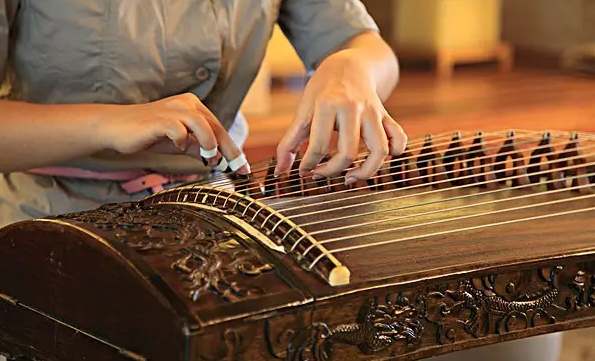Quick Learning Cheats for Guzheng
1. In the process of practicing quick skills, you must master a key to relax one by one. Only by fully relaxing the muscles of the shoulders, arms, elbows and wrists, can all the strength be concentrated on the fingertips. If there is tension in any part, the force will be weakened in the process of being sent to the fingertips, and the flexibility of the fingers will be restrained at the same time. It was as if a clear spring descended from the top and was suddenly cut off halfway. Therefore, we should relax ourselves without stiffening the muscles so that the fingers can be actively mobilized. If this is not the case, the arm will be used as a fulcrum to drive the wrist, thereby driving the fingers, so that the arm, wrist, and fingers are all in a state of tension, which not only affects the playing speed, but also affects the tone and clarity. The so-called playing the piano is to use the fingers to play, with the base of the finger as the fulcrum, the smaller the movement of the finger, the faster the speed; the larger the movement, the slower the speed.
2. When practicing quick skills, don't be in a hurry. In the initial basic skills training, you should consciously slow down the speed and increase the intensity. For example, a sixteenth note is played into an eighth note, and a quarter note is played into a half note. After the finger muscles gradually adapt to this process, gradually increase the speed and increase the density. In addition, we can also do exercises to change the rhythm, such as: adding a dot in the middle of the evenly distributed notes, or adding a note in the middle of two average notes, changing the original rhythm, and making the fingers adapt to the frequent changes of various complex rhythms . Next are several exercises for finger muscles:
1. Fast four-point practice: You can train your fingers to have a relatively fixed position to avoid collisions during playing. In particular, pay special attention to the big finger, which must be placed on the outside of the index finger and go its own way.
2. String sticking practice: The fingers cannot be tied, and they cannot leave the strings at the same time, so as to train the fingers to take the initiative to walk alternately, and lay a good foundation for the rolling exercises of the fingers in the future. This exercise emphasizes two points: one is strength; the other is speed, you can't play casually.
3. Finger fingering rolling practice: This training must be done on the basis of the string sticking practice, otherwise the strength, speed and control ability of the fingers will not meet the new requirements. Through this training method, the fingers must be active and active. When the former finger is playing the string, the latter finger must be ready to fall, and the fingers will fall at the same time. Especially for the fourth and second fingers, it is necessary to focus on training, because the muscles of these two fingers are relatively weak, pay attention to slow down and then fast, gradually accelerate, maintain the strength, and the strength should be uniform, and the popped tone should be uniform. Only after these systematic training can the fingers exert their initiative, the muscles can be exercised step by step, and they can be fast and not chaotic when playing fast skills, and finally reach or even exceed the original speed.

3. The practice of fast skills should vary from person to person. According to each person's different physiological conditions, make a corresponding training plan, and can't blindly grasp it. Some people with poor finger muscles should develop the four fingers and use the principle of symmetry and quality to make each playing finger use its root joint as a fulcrum to get rid of the restriction of the wrist. Initially, start from a slow speed, average the abilities of each finger, and gradually master the law of symmetry and inertia (when playing, take the wrist joint as the fulcrum, do a back and forth swing, this kind of symmetrically changing the center of gravity and moving back and forth. The way of playing is called "symmetry". The inertia is to complete the multi-tone and multi-fingered playing while maintaining a movement trend), and then perform the conversion between symmetry and inertia, so that the hand can adjust the center of gravity and move at any time. direction conversion. When switching between different playing methods, whether it is symmetry into inertia, inertia into symmetry, or inertia into another form of inertia, the transition should be made through symmetry. Because symmetry is ubiquitous and used in traditional playing techniques, only by performing various transformations on the basis of symmetry can we be fast and not chaotic in fast playing, so as to obtain maximum relaxation and flexibility. This will give full play to the flexibility of the fingers to achieve the best results. People with strong finger muscles should adopt a comprehensive exercise method during the training process. When playing traditional zheng music, use the fast four-point technique (that is, play through the rapid alternation of the middle finger, the big finger, the index finger to hook, hold, and wipe), in modern pieces such as "Fighting Tigers Up the Mountain", "The Sun is Red on Jinggang Mountain", You can use the prescribed fingering technique, or you can customize the fingering suitable for personal playing according to your own conditions.
 渝公网安备 50010702504639号
渝公网安备 50010702504639号